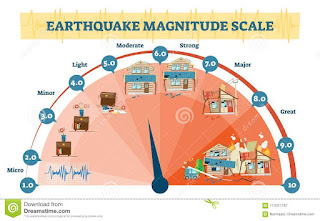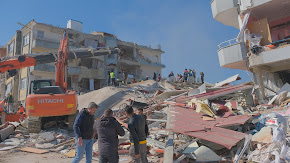From Pompeii to Haiti to Turkey 2023: "A Timeline of Deadly Earthquakes Throughout History"
Introduction:
Earthquakes are one of the most destructive natural disasters that occur on our planet. They can cause widespread damage to buildings, infrastructure, and communities, and can result in a significant loss of life. In this blog, we will explore what earthquakes are, the different types of earthquakes, and some of the most deadly earthquakes in history.

Definition:
An earthquake is a sudden and violent shaking or trembling of the Earth's surface caused by the movement of tectonic plates, volcanic activity, or human activities such as underground blasting or construction or by the release of energy from the Earth's crust. Earthquakes can vary in intensity, from minor tremors that go unnoticed to catastrophic events that cause extensive damage and loss of life. The intensity of an earthquake is measured on the Richter scale, which ranges from 1 to 10, with each increase in number indicating ten times more energy released. Earthquakes can also trigger other natural disasters such as landslides, tsunamis, and volcanic eruptions.
Types of Earthquakes:
There are several types of earthquakes amongst them 4 are famous;
- Tectonic earthquakes
- Volcanic earthquakes
- Collapse earthquakes
- Explosion earthquakes
- Tectonic earthquakes: These earthquakes are caused by the movement of tectonic plates, which are the large, slow-moving slabs of rock that make up the Earth's crust. When two plates rub against each other, they can cause an earthquake.
- Volcanic earthquakes: These earthquakes are caused by the movement of magma and volcanic gases beneath the Earth's surface. They are often associated with volcanic eruptions.
- Collapse earthquakes: These earthquakes occur when underground mines, tunnels, or other man-made structures collapse.
- Explosion earthquakes: These earthquakes are caused by the detonation of nuclear devices or other large explosions.
Ancient Earthquakes:
The earliest recorded earthquake in history took place in China in the year 1177 BCE. While details about the event are scarce, it is believed to have caused widespread destruction and loss of life. In the centuries that followed, earthquakes continued to wreak havoc across the ancient world. In 62 CE, the Roman city of Pompeii was devastated by a powerful earthquake, killing thousands and leaving the city in ruins. The eruption of Mount Vesuvius just 17 years later would bury the city and preserve it for centuries to come, offering a glimpse into life in ancient Rome.
- Medieval Earthquakes: The Middle Ages saw their fair share of deadly earthquakes, as well. In 856 CE, a massive earthquake struck the city of Damghan in modern-day Iran, killing an estimated 200,000 people. In 1138 CE, the city of Aleppo in Syria was hit by an earthquake that killed an estimated 230,000 people, making it one of the deadliest earthquakes in recorded history.
- Modern Earthquakes:While the ancient and medieval worlds were certainly no strangers to earthquakes, the modern era has seen some of the deadliest and most devastating earthquakes in history. In 1755, Lisbon, Portugal, was hit by a massive earthquake, followed by a tsunami and subsequent fires. The disaster killed an estimated 60,000 people, nearly a third of the city's population.
- In 1906, San Francisco was struck by a powerful earthquake that resulted in a massive fire that destroyed much of the city. The disaster killed over 3,000 people and caused billions of dollars in damage. In 1923, the Japanese city of Tokyo was hit by a magnitude 7.9 earthquake that killed over 100,000 people and destroyed much of the city.
- The 2010 earthquake in Haiti was one of the deadliest in modern history, killing over 200,000 people and leaving millions homeless. The earthquake, which had a magnitude of 7.0, caused massive destruction across the country, and it took years for the country to recover fully.
- More recently, the 2023 earthquake in Turkey and Syria was one of the deadliest in modern history, killing over 50,000 people and leaving millions homeless. The earthquake, which had a magnitude of 7.8, caused massive destruction across the countries.
Deadliest Earthquakes in History:
Throughout history, there have been many devastating earthquakes that have caused widespread damage and loss of life. Here are some of the deadliest earthquakes in history:
- Shaanxi earthquake (China, 1556): This earthquake is estimated to have killed between 830,000 and 870,000 people, making it the deadliest earthquake in history.
- Tangshan earthquake (China, 1976): This earthquake killed an estimated 242,000 people and destroyed much of the city of Tangshan.
- Haiti earthquake (Haiti, 2010): This earthquake killed an estimated 316,000 people and caused widespread damage to the country's infrastructure.
- Great Kanto earthquake (Japan, 1923): This earthquake killed an estimated 142,800 people and caused widespread damage in the Tokyo and Yokohama areas.
- Indian Ocean earthquake and tsunami (Indonesia, 2004): This earthquake, which was followed by a massive tsunami, killed an estimated 230,000 people in several countries around the Indian Ocean.

Early warnings:
Earthquake forecasting could help in other regions as well. California, for example, which is home to the massive San Andreas fault, has implemented the beginnings of an early-warning system that relies on networks of seismometers to detect the very start of a quake. That can provide seconds or minutes of advance notice to Californians to ‘drop, cover and hold on’ while automatically triggering life-saving measures such as slowing trains to a stop.
In 2002, Turkey implemented an early-warning system in Istanbul that will slow trains, open lift doors and shut down critical processes in factories in the case of an earthquake. The country has also implemented building codes, but many scientists were concerned that they weren’t being enforced rigorously enough. Mustafa Erdik, a retired civil engineer at Boğaziçi University in Istanbul and president of the Turkish Earthquake Foundation, agrees that this was the case — arguing that ignorance, incompetence and implicit collusion between architects, inspectors and builders were at fault.
Lessons Learned:
While earthquakes have caused untold suffering and devastation throughout history, they have also led to important lessons learned about how to prepare for and respond to these disasters. In many parts of the world, building codes have been updated to include seismic-resistant design features that can help to reduce the impact of earthquakes on structures and infrastructure.
Early warning systems have also been developed in some areas to provide people with critical information about incoming earthquakes, giving them valuable time to take cover or evacuate if necessary. Education and awareness campaigns have also been developed to help people understand the risks posed by earthquakes and the steps they can take to protect themselves and their families.
Conclusion:
From ancient Pompeii to modern-day Haiti, earthquakes have been some of the most devastating natural disasters in human history. While we cannot prevent earthquakes from occurring, we can learn from the lessons of the past and take steps to prepare for and respond to these disasters in a more effective way. By investing in earthquake-resistant infrastructure, early warning systems, and public education and awareness campaigns, we can reduce the impact of earthquakes on human life and help to ensure a safer and more secure future for all.
Earthquakes are a powerful and destructive natural phenomenon that can cause significant damage to infrastructure, communities, and the environment. While we cannot predict when or where earthquakes will occur, we can take steps to prepare for them and reduce their impact. By understanding the different types of earthquakes and their effects, we can work together to minimize their impact on our lives and our planet.






-16033442.jpg)






Comments
Post a Comment